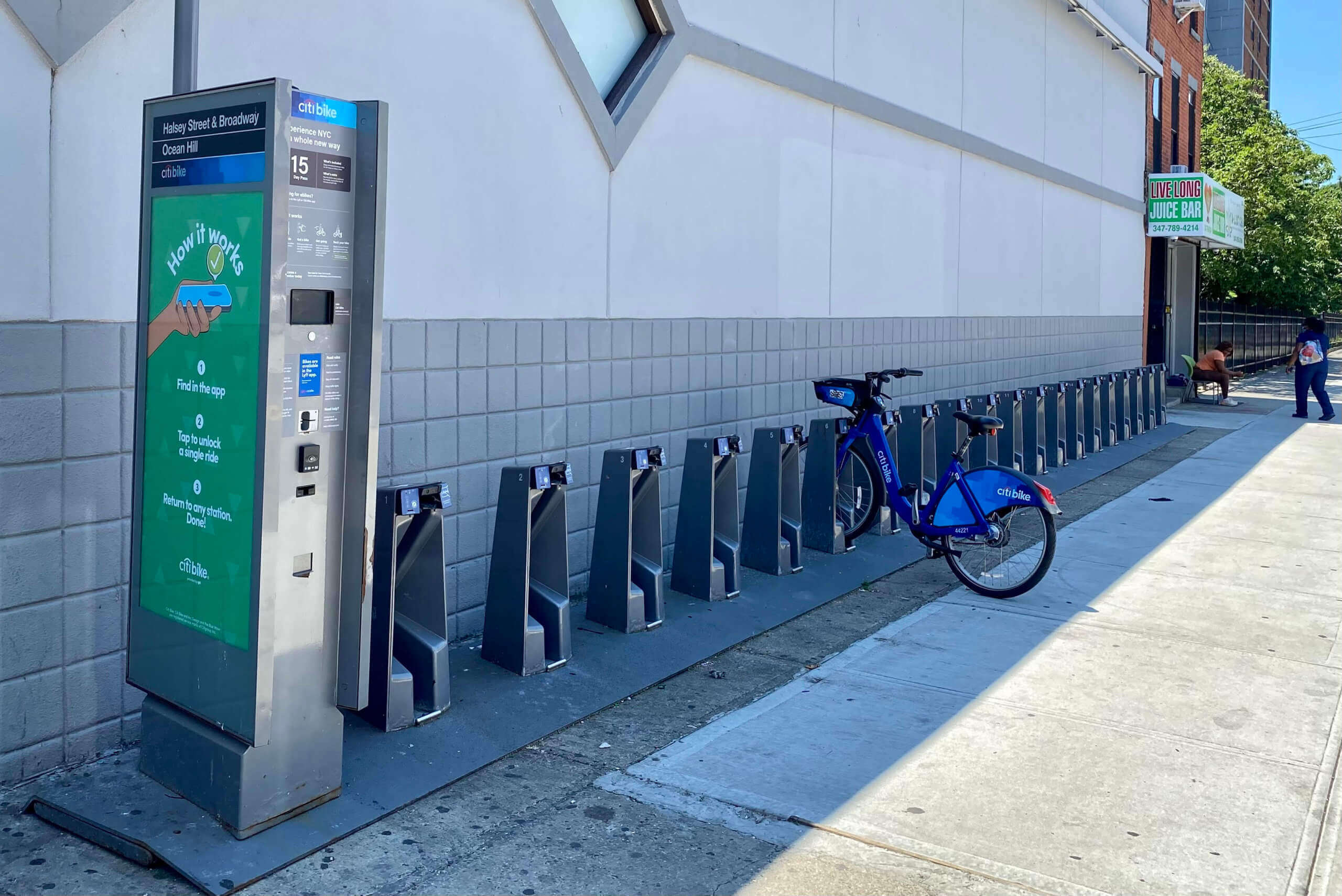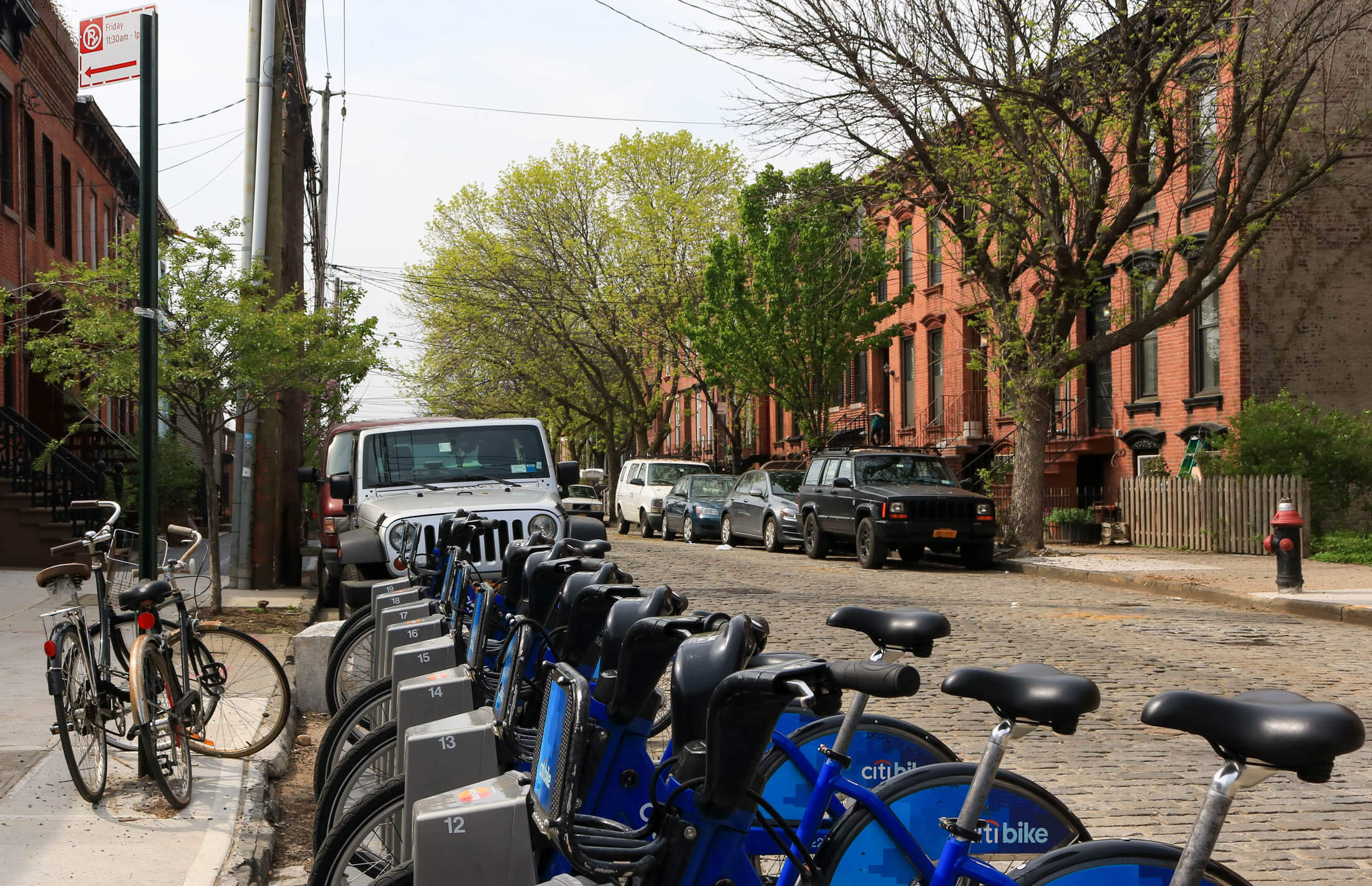More Than 100 New Citi Bike Stations Coming to Central and East Brooklyn This Fall
After three years of planning, the Department of Transportation is set to start work this fall installing around 120 new Citi Bike stations in parts of central and east Brooklyn that are currently Citi Bike deserts.

A rack in Brooklyn Heights in May. Photo by Susan De Vries
After three years of planning, the Department of Transportation is set to start work this fall installing around 120 new Citi Bike stations in parts of central and east Brooklyn that are currently Citi Bike deserts.
Some of the stands will be installed on sidewalks and others will be installed on the road, draft maps released by DOT show. The maps are still being finalized, and a DOT rep told Brownstoner that after final rounds of community feedback the updated plans will be released at the end of summer.
The stands will all be located in parts of Bed Stuy, Crown Heights, Ocean Hill and Flatbush that are not currently covered by the Citi Bike network; all fall within Community Boards 3, 5, 8, 9 and 16. With a number of the stations being installed on the road, certain streets will lose some parking spaces, although DOT did not confirm the number. A loss of parking that has come with new Citi Bike stations has proven controversial in some parts of the city, although less so in Brooklyn. The service’s expansion counters criticism the initial rollout favored wealthier, whiter parts of the borough.
citibike-draft-plan-map-bed-stuy-2022-DOT
citibike-draft-plan-map-crown-heights-2022-DOT
citibike-draft-plan-map-crown-heights-flatbush-2022-DOT
citibike-draft-plan-map-ocean-hill-2022-DOT
Currently, there are no Citi Bike stations south of Lincoln Road in Flatbush or east of Rogers Avenue. In Crown Heights, there are none south of Atlantic Avenue, and in Bed Stuy there are none east of Lewis Avenue and a black west of Broadway in the pocket between Fulton Street and Broadway.
The new stations will increase accessibility by making more bikes available in more spots. Oftentimes stations on the outer edge of service areas have few bikes available, while in other more Citi Bike saturated neighborhoods (such as Williamsburg), stations can be packed to the brim, making it difficult to find a spot to park.


Department of Transportation Spokesperson Tomas Garita told Brownstoner the DOT is working hard to implement Citi Bike’s phase three expansion, “increasing access to bike share in more low-income communities and communities of color.”
“We are working closely with our community partners to identify the most optimal locations to place new Citi Bike stations. Upon the completion of phase three installations, more than half of the city’s population will live within the Citi Bike service area, bringing this essential resource to disinvested communities.”
DOT started the expansion planning in 2019 to maintain a dense and contiguous service area. Station locations were determined through community input (DOT collected 775 public comments on the expansion) and technical siting, which took into account accessibility and sidewalk width, parking and truck loading, and proximity to street furniture and underground utilities, DOT documents show. The stations are not hardwired into the ground and are solar powered and wireless.
Citi Bike first launched in Manhattan and Brooklyn in 2013 with 330 stations and 6,000 bikes. Between 2015 and 2017 it added Queens to its network and increased stations to 750, and bikes to 12,000. This third expansion is increasing services in Manhattan, Brooklyn and Queens, and is also taking Citi Bikes to the Bronx. The expansion will double the number of bikes yet again to 24,000, DOT documents show.
To date, DOT docs say more than 140 million trips have been made on the bikes, and more than 27 million of them occurred in 2021. Each bike makes an average of five trips per day, and the service attracts 100,000 daily trips in peak riding months. In 2021, there were one million unique riders, DOT docs say, and 160,000 annual members. Single rides cost $3.99 for 30 minutes and a day pass is $15. Annual memberships go for $185 and monthly passes are $15 if a year-long commitment is made.
NYCHA residents and SNAP recipients can get memberships for $5 a month with no annual commitment, and Community Development Credit Union members can also get $5 a month memberships, but with an annual commitment.
Related Stories
- Citi Bike Starts Installing Stations in Bed Stuy
- Citi Bike Makes It Easier to Get Around Brooklyn — Well, Some of It
- City Mulls Millions to Knit Together Bike and Ped Greenway Network in Brooklyn and Queens
Email tips@brownstoner.com with further comments, questions or tips. Follow Brownstoner on Twitter and Instagram, and like us on Facebook.





What's Your Take? Leave a Comment